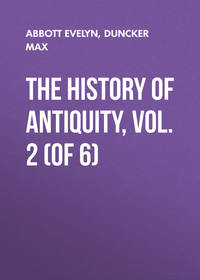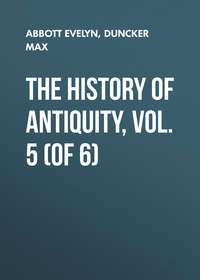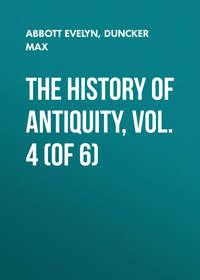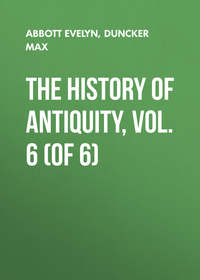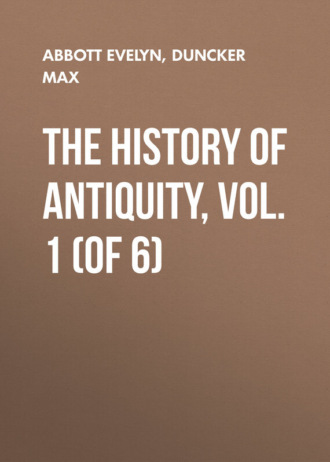 полная версия
полная версияThe History of Antiquity, Vol. 1 (of 6)
Below Memphis lay On, the city of the sun (Heliopolis). Here the spirit of the sun, Ra, was the pre-eminent god. In Manetho's list Ra succeeds Ptah in the kingdom. "The Egyptians," says Plutarch, "regard the sun as the body of the beneficent power, the visible form of a being only comprehensible to thought. The morning sun they represented as a new-born child seated on a lotus leaf, and thrice each day – at sunrise, noon, and sunset – they offered incense to Helius."36 We also find that the Egyptians represented the sun of the winter months as a little child, the sun of the vernal equinox as a youth, that of the summer solstice as a bearded man, and again, the sun of the autumnal equinox as an old man.37 Hence they looked at the yearly course of the sun under the allegory of human life. Plutarch's remark about the morning sun shows that they regarded the daily course of the sun from the same point of view, and when he tells us that according to Egyptian story, Apopis made war against the god of the sky,38 his statements are confirmed by the monuments. According to the inscriptions Ra is "revealed in the abyss of the sky," he is throned "in the orb of the sun," "he moves his egg." "A Supplication to Ra" – such are the words of a prayer – "who each day by himself brings himself to a new birth. Ra has created all that is in the abysses of the sky."39 In the tombs of the Ramesids, at Thebes, the course of the sun is represented by the hour of the day and night. On the form of the blue outstretched goddess of the sky appears the boat of the sun, for the Egyptians conceived the sun as navigating the air in a skiff, as they navigated the Nile; and in the boat is Ra, a child with finger in mouth at the first hour of the morning. As the day goes on the child increases in size, and at every hour the spirits who lead the boat are changed. In the hours of the afternoon the evil serpent, Apep, the darkness, the Apopis of Plutarch, attempts to swallow the sun, but twelve spirits draw the serpent by ropes to the side. In the hours of the night the sun-god is inclosed in his shrine on the boat, which is carried along by spirits changing every hour over the waters of the under world to the east – just as the boats on the Nile are drawn against the stream – so that he may again shine out in the east on the next morning. The hieroglyphics accompanying the navigation of the night hours contain seventy-four invocations of Ra in Amenti, i. e. in his concealment. In a similar way the monuments of Edfu exhibit the growth of the sun-god through the twelve hours of the day from a child to a youth and a man, and an old man bowed with age, leaning upon a staff. This last is called in the inscriptions, "The old man who becomes again a child."40
The monuments exhibit Ra in red, with the sun's orb on his head, a sceptre in one hand, and the symbol of life in the other. The cat, the tawny bull, and the hawk are the chosen creatures of Ra; often he is found on the monuments with the head of a hawk in the place of the human head, or as a hawk carrying the sun's orb. All the entrances of the temple and the pylons display the symbolical form of the deity, the sun's orb, supported by two wings. From the sun-god the kings of Egypt derived their might and power. They generally call themselves "the sons of Ra," and they rule over Egypt as Ra rules over the world.
Hence we can assume that to the minds of the priests Ptah was essentially the deity of beginning, the first originator of creation. Ra again was the propagating and sustaining power of the divinity embodied in the sun.
At Hermopolis (Ashmunein), besides Thoth, whom the Greeks compared to their Hermes, and the inscriptions name the "Lord of divine truth," the "scribe of truth," to whom the white Ibis with black neck and beak is sacred, the "children of Ptah" were worshipped. These were eight gods in four pairs. Owing to this worship Hermopolis was known to the Egyptians as Pe-sesennu, i. e. "the city of reverence." These children of Ptah seem to have been spirits of the elements. In an inscription at Edfu we find, "The eight gods, the very great, who are from the beginning, created before the gods, the children of Ptah, arising through him, begotten of him, to take possession of the south and the north, to create in the Thebaid, and fashion in the land of Memphis. When they arose the stream flowed out from the young waters, the child of the lotus flower rose up in the boat, the beautiful one, making this earth bright by his beams."41
At Sais, at Buto, on the Sebennytic mouth, and at Bubastis (Tel Basta), on the Pelusiac arm of the Nile, female goddesses were worshipped. To the feast of the goddess of Sais, whom the Greeks called Athene, the Egyptians came from the whole country, as Herodotus tells us, to Sais, and lighted lamps on the appointed night, and even those who did not come to Sais lit lamps, so that lamps were burning throughout all Egypt.42 Jamblichus and Proclus tell us that the goddess of Sais, the Neith of the Egyptians, was the mother of the sun-god; the inscriptions call Neith "the cow which bore the sun," "ancient mother of the sun," "mother of the gods." Hence we may assume that Neith was associated with Ptah, whose green colour she shares on the monuments; and that the creative power of nature was personified in her under a female form. The feast of lamps may have symbolised the birth of light, and its rise from the darkness.43 The goddess of Buto, who was also worshipped at Letopolis, near Memphis, was compared by the Greeks with their goddess Leto, whose child was Apollo, the spirit of light, because at Buto the victorious god of light of the Egyptians, of whom we shall speak below, was said to have grown up.44
The sanctuary of the goddess at Bubastis was, according to Herodotus' account, the most delightful, though not the largest or most costly, in the whole of Egypt. It was situated in the middle of the city, and could be seen from every side. "Beyond the market-place a paved road, about forty feet in width, leads to the shrine, which is overshadowed by trees on both sides. The precincts, a place of about a stadium square, is surrounded with a trench one hundred feet broad; this is connected with the Nile, and also planted with trees. The portico is ten fathoms high, and adorned with statues six cubits in height, and well worth description. On the external walls pictures are everywhere engraved, and the temple in which the statue of the goddess stands is also surrounded by very lofty trees. At the festival of the goddess the Egyptians from all the land go down in boats to Bubastis: in every boat is a number of men and women; some of the men blow the flute; some of the women have castanets, and strike them; the rest sing and clap their hands. The boat touches at every city on the river bank; and here also the women sing and strike their castanets, while others follow the women of the city with shouts and raillery; others, again, dance; others expose themselves. On arriving at Bubastis, they bring large offerings to the goddess, and drink more wine at this festival than in all the rest of the year. According to the accounts of the Egyptians, about 700,000 men and women are collected at this festival, without counting children.45
Herodotus calls the goddess of Bubastis Artemis: her Egyptian name was Bast and Pacht; and the city was called after her Pa-Bast, i. e. "abode of Bast." On monuments this goddess has the sun's disk upon her head, or, in the place of a human head, the head of a cat, which animal was sacred to her. At Heliopolis there was a picture of Ra in the form of a he-cat;46 and in the inscription Pacht is called the daughter of Ra. Ra was invoked to come to the help of his daughter, the holy she-cat, who was panic-stricken by the snake which approached heaven in order to tread upon the path of the sun-god, and to defile the limbs of the holy she-cat.47 In the sketches in the "Book of the Dead" we find a she-cat, with the right forefoot upon the head of a serpent, and in the left a broad knife, with which she is cutting off the head of the serpent.48 The account given by Herodotus of the customs observed at the festival are confirmed from other sources. The monuments exhibit musicians, whose music is accompanied by the audience with clapping of the hands; and Plutarch describes the castanets of the Egyptians adorned with the figure of a human-headed she-cat, the sound of which was intended to scare away the evil spirit.49
In the upper country other deities were worshipped. At Thebes, Amun, known to the Greeks as Ammon, took the place occupied by Ptah at Memphis. Hecatæus of Abdera relates that the Egyptians identified their supreme god with the universe, but the god was invisible and concealed.50 Amun, as a fact, signifies "the concealed" or "veiled." The monuments of Thebes exhibit him as a creative god with the Phallus, as a ruling deity either standing or sitting on a throne; on his royal head-dress are two upright feathers, which to the Egyptians were the symbol of dominion over the upper and under world, and in his hand are the sceptre and the symbol of life. His colour is blue. By his side stands the goddess Mut; the "mother," the "lady of darkness," as the inscriptions51 style her. She wears on her head the vulture, or the crown of Upper Egypt. She is also found on inscriptions with the head of a vulture, the bird sacred to her, instead of a human head; and in pictures of battles the vulture of Mut hovers over the Pharaoh as the symbol of protection. The son of Ammon and Mut is Shu (Sosis, Sos), the spirit of the atmosphere, "the bearer of heaven," as the inscriptions name him.52 This (Thinis) and Abydus were the chief seats of his worship. In Manetho's list the reign of Shu follows on those of Ptah and Ra.
In the place of Ammon we often find another divinity, Tum (Atmu.) This was the sun-god in a special form. In Upper Egypt the spirit of the sun was invoked under the names Tum and Mentu. Of these names the first signified the declining sun, the sun of the west, the sun of concealment, the sun in the under world; the second the rising sun, the sun of the east, the sun of the day, the bright sun-god. Tum also wears the double crown, and the two feathers of Ammon, or in the place of them the two royal serpents round his head-dress; he also is lord of both kingdoms. Like Ptah, he is "the father of beginnings, who begot himself," "the father of the gods;" like him also he is formed with the beetle in the place of the human head; as the creative god he is the creator of his name, i. e. of his properties; he is the primæval night, the darkness of the beginning, before light existed. To him also belonged the primæval water. According to Plutarch, the Egyptians believed that the sun arose out of moisture, that it sprang up out of water, and was nourished by it, and therefore water was the beginning and origin of things. This account is confirmed by the monuments. As light in the process of production, Tum is called "Ra in his egg;" and as the spirit of light arising out of darkness and water, the horologe and the sun-dial are his insignia.53
At Coptus, in Upper Egypt, a phallic god was worshipped under the name Chem, whom the Greeks compared to their god Pan, and at the falls of Syene a ram-headed god, Chnum (Chnemu, Chnuphis, Kneph), who in inscriptions is named the lord of the "inundations," of the "outpouring of the waters."54 As a giver of fruits, the colour of his pictures on the monuments is generally green. In the eyes of the inhabitants of Upper Egypt Chnum was, according to the account of Plutarch, an uncreated eternal spirit.55 We must therefore regard him as a peculiar form of the life-giving god. Chnum was often united with Ammon, inasmuch as the latter assumes the attributes of Chnum, the ram's horns or even head.56 As the worship of Ammon passed beyond Egypt up the Nile as far as Meroe, so the worship of Ammon-Chnum spread westward in the Libyan desert as far as the oasis of Siwa, where the inhabitants were called by the Greeks Ammonians. Here, even now, in the vicinity of a clear pool surrounded by lofty palms, the remains of a considerable temple are to be seen, with hieroglyphic inscriptions, and the picture of the ram-headed deity.57
The worship of the goddess Hathor was widely diffused both in Upper and Lower Egypt. The most renowned seats of the cultus were Aphroditopolis, near Memphis; Edfu and Dendera, in Upper Egypt. She is called in the inscriptions "the lady of the dance and revel," and is represented on the monuments with fetters and a tambourine in her hands. From this and from her Grecian name we may conclude that she was the Egyptian goddess of love, of the enchaining passion; but though we find in her form hints of a more individual and lively fancy, the natural power of maternity in general is by far the most prominent conception. She is represented with the horns of a cow – her sacred animal – on her head, and between them the moon's disk; or entirely as a cow. In the rock-temple at Abusimbel, which the wife of Ramses II. dedicated to Hathor, she is represented as a cow in a boat, over which water-plants meet in arches. To this cow the king and queen offer flowers and fruits.58 In the temple at Edfu, a structure of the Ptolemies, 360 local forms of Hathor are said to have been enumerated and among these seven were especially prominent.
It was the beneficent, creative, and life-giving powers of nature which the Egyptians worshipped in these divinities – water, light, the clear heaven, the sun, the powers of reproduction and birth. But the phenomena and the powers presented by nature were not in every case beneficent. Night swallowed up day, and death swallowed up life. Beside the waters and the black fruitful soil of Egypt lay the boundless yellow desert, from which storms blew the sand into the green valley. In the hot months, the sun blazed with a devouring and scorching heat, the flowers withered; and the powers of nature failed in the winter. Thus in the life of nature there was a strife between malignant and beneficent powers, a strife in which nevertheless the beneficent powers always gained the upper hand. Out of night arose a new day; out of the death of nature in winter blossomed forth new increase, fruitfulness, and life. Through this conception of a strife raging between the healing and destructive powers of nature, by regarding nature as moving in a circular course from life to death, and death to life, the Egyptians succeeded in making a great advance in their religious ideas. They personified this strife in certain divine forms. The beneficent power, the divinity of life was allowed to succumb, and then to rise from apparent death into a new life. Only for a moment could the evil powers vanquish the good; the eternal victory remained with the gods of beneficence.
After Helius, Hephæstus, Ammon, and Hermes, says Diodorus,59 Cronos and his sister Rhea ruled. These became the parents of Isis and Osiris, of Typhon, Apollo, and Aphrodite. Plutarch tells us that, according to the legend of the Egyptians, Rhea and Cronos were the parents of Osiris and Isis, of Typhon and Nephthys. Osiris ruled happily over Egypt; but Typhon conspired against him with seventy-two associates; they inclosed Osiris in a chest and threw it into the Nile, and the stream carried it down to the sea. When Isis heard of it, she put on mourning, and sought with lamentation the body of Osiris. At last she found the chest in the neighbourhood of Byblus, where the sea had cast it up; she mourned over the corpse and carried it back to Egypt. And when Horus, the son of Isis and Osiris, who grew up in Buto, came to his full strength, he prepared to avenge the wrong which Typhon had done to his father and mother. Thrice he fought with Typhon; the battle raged for many days, and Horus conquered.60
According to the accounts of Herodotus and Diodorus, Osiris (Dionysus) and Horus (the Apollo of the Greeks) were the last rulers of the divine race.61 In the list of Manetho, Ptah was followed in the kingdom by Ra and Shu (or, according to the Theban account, by Ammon, Tum, and Shu), Cronos, Osiris, Typhon, and Horus. These then are the younger gods; the evidence of the monuments shows that they were connected by race with each other, but not akin to the three gods who ruled before them. And as we also find that the five supplementary days added in the Egyptian year to the original number of 360 (p. 29) were dedicated to these gods, the first to Osiris, the second to Horus, the third to Typhon, the fourth to Isis, the fifth to Nephthys – the natural conclusion is that these gods were of later origin.62 On the other hand it is clear that the belief in Osiris and his power had already arisen at the time when the great pyramids were erected.
The two gods at the head of this circle, whom Diodorus and Plutarch call Cronos and Rhea, were known to the Egyptians under the names Seb and Nut.63 They are the spirits of the earth and sky. Osiris himself in the inscriptions and records is called "the king of the gods," "the lord of unnumbered days," "the king of life," "the regulator of eternity." The inscription on the lid of a coffin runs thus – "Ra gave thee the richly streaming light which gleams in thy eyes. Shu gave thee the pleasant air which in thy lifetime was inhaled in thy nostrils. Seb gave thee all fruits whereon thou livest. Osiris gave thee the Nile-water whereon thou livest."64 As a life-giving god, the colour of Osiris is green; his sacred tree is the evergreen tamarisk; and his sacred bird a kind of heron, distinguished by two long feathers at the back of the head. Osiris is always represented in a human form, and with a human head.
The chief seats of the worship of Osiris were Philæ and Abydus, in Upper Egypt. In the temple on the island of Philæ, formed by the Nile above Syene, the history of the god was represented.65 On a little island close by, where only the priests might tread, lay the grave of Osiris, overshadowed by tamarisks;66 here were libations offered to him, and Diodorus tells us that in Upper Egypt no more sacred form of oath was known than the oath by Osiris who rests at Philæ.67 In the temple of Osiris at Abydus (Arabat-el-Medfuneh) the wealthy Egyptians sought to be buried, that they might rest in the vicinity of the god's grave. In Lower Egypt Osiris68 was worshipped in the cities of Memphis, Sais,69 and Busiris. At Busiris (the name Pe-osiri meant "abode of Osiris"), on the Sebennytic arm of the Nile, in the middle of the Delta – it was the chief city of the district of Busiris – was situated the largest temple of Isis, as we learn from Herodotus, and here also, according to other evidence, the grave of Osiris was to be found.70 Here the whole land worshipped this god and goddess.71 Thousands of men and women assembled, according to Herodotus, made lamentation for Osiris, and brought an offering to the greatest goddess (Isis). Amid prayers the bull was flayed, the thighs and other parts cut out, and a part of the belly filled with bread, honey, and incense; these were drenched plentifully with oil, and set on fire, and so long as the sacrifice burned the people lamented. When the lamentation ended, the remainder of the sacrifice was eaten.72 Plutarch says that with Osiris the Egyptians lamented the receding of the Nile, the ceasing of the cool north wind, the death of vegetation, and decrease in the length of the day. On the 17th Athyr, the day on which Typhon slew Osiris (on this day the sun passes through the Scorpion), the priests instituted rites of lamentation, and, among other things, as a sign of the sorrow of Isis, they exhibited for four days a gilded cow, covered with a black veil of byssus – for the cow was the Egyptian symbol of this goddess. On the 19th Athyr, in the night, they went down to the sea, and the priests brought out the chest, and the congregation cried, "Osiris is found!"73 Moreover, according to Plutarch, the holy rites represented the burial of Osiris: in these the wood was cut for the chest, the linen torn for cerements, and libations poured. A serpent was also slain in effigy.74 About the time of the winter solstice, as Plutarch tells us in another place, the Egyptians carried "the cow," i. e. Isis, seven times round the temple, and this procession was called the search for Osiris.75 On the monuments the Isis worshipped with Osiris appears generally in a youthful shape, with the horns of a cow on her head, the moon's disk between the horns, with the flower-sceptre and symbol of life in her hands. The inscriptions denote her as the "royal consort," the "great goddess." An image in which she was represented in the form of a cow was seen by Herodotus in the royal palace of the last Pharaohs at Sais. "In a beautifully-adorned chamber lay the wooden image of a cow, resting on her knees, not larger than a full-grown cow. The body was covered with a purple robe; on the neck and head could be seen the thick gilding, and between the horns a golden disk. Every day incense was burned before the image; and at night a lamp was kindled before it. Once a year," continues Herodotus, "this cow was carried out into the open, when the Egyptians lamented the god, whose name I do not think proper to mention now."76
Osiris and Isis, the spirits of blessing and life, were attacked by Typhon. Plutarch observes that the Egyptians called Typhon Set,77 and this statement is confirmed by the inscriptions. The colour of Set was burning red,78 like the glowing sun in the dust of the desert; the ass was the sacred animal of this god, and a peculiarly-formed animal his symbol on the monuments. In poisonous serpents also the Egyptians saw this destructive deity, and they brought the crocodile and hippopotamus into association with him. The third of the five additional days of the year (p. 29), which belonged to Set, was to the Egyptians an unlucky day.79 On a papyrus he is called "the almighty destroyer and blighter,"80 and with this agrees the statement of Plutarch, that Typhon, according to the Egyptians, had filled the whole earth and sea – which they call "the foam of Typhon" – with evils; and they considered all animals, trees, and vegetables, all incidents of a harmful and destructive nature to be works, parts and actions of Typhon.81
The evil god can limit and overcome the beneficent power of nature, but not for ever. Osiris had left behind a young son, who could hold Typhon in check, though unable to suppress him entirely. Horus, as Plutarch tells us, was born about the time of the winter solstice, and the festival of the delivery of Isis was celebrated at the time of the vernal equinox.82 On the monuments we find Horus (Har), "the avenger of his father Osiris," as the inscriptions call him, represented as a naked child, with finger on lip, sitting on a lotus-leaf, or on a crook, the symbol of dominion. Hence he is the young Horus, the Harpocrates of the Greeks, the Harpechruti —i. e., "Har, the child" – of the Egyptians. Then, according to the legend, he grows up at Buto; he becomes a handsome youth, the strong Horus (Har-ver, Arveris of the Greeks), the "great helper," the "pillar of the world." In the temple at Philæ we see him pouring libations before the bier of Osiris; on other monuments he guides the sun's bark through the hours of the day.83 At Hermopolis, as Plutarch tells us, a hippopotamus was to be seen, on which a hawk – the sacred bird of Horus, in which form the god is often represented – fought with a serpent; and, according to the belief of the Egyptians, Typhon escaped from Horus in the shape of a crocodile.84 The monuments represent Horus on the sun-boat in the act of stabbing a serpent with a human head,85 i. e., Apopis, the serpent Apep; or standing on crocodiles with serpents in his hands; or as a winged sun's disk contending with a hippopotamus. In an invocation of Horus, belonging to the fourth century B.C., we find the following: "Come to me quickly on this day to guide the holy bark (the sun's-boat), to force back all lions to the land of Egypt, and all crocodiles into the Nile. Shamelessness and sin (?) come and appear upon earth; but when Horus is invoked he destroys them. All mankind rejoice when they see the sun. They praise the son of Osiris, and the serpent turns back."86 Hence to the Egyptians Horus was the triumphant god of light (Har-phre, Horus-sun), who subdues gloom, and winter, and drought. As a victorious god arousing fresh life, he gives to the kings of Egypt life and victory. The Greeks called the Egyptian Ra Helius, and Horus Apollo; and these names correspond to the Egyptian conception of these deities. The chief seats of the worship of Horus were the two cities which the Greeks called the great and little cities of Apollo (Edfu and Kus) and Ombus. At Edfu Hathor was worshipped beside Horus (p. 52).


